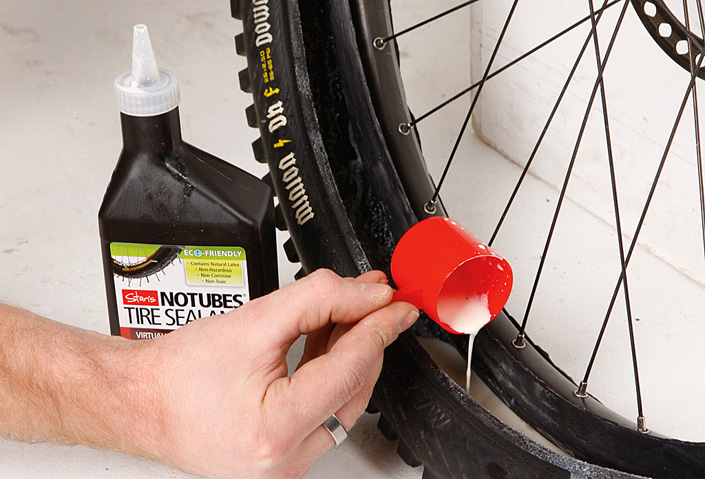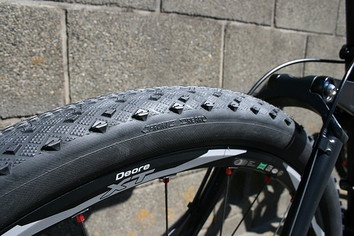
The great debate on "going tubeless" has raged for centuries. Well, not quite... perhaps ages. How do you do it? What are the advantages? Any drawbacks? All those questions and more answered here...
What does "going tubeless" mean?
Quite simply, going tubeless means relying on the tire and rim, and not an interior tube, to hold air in. Car wheels moved on from tubes decades ago, but only in the last 6-8 years have tire and rim manufacturers embraced the concept, making it practical for the casual user.
How? By improving the tire itself, the seal where it joins the rim (known as the 'bead'), and by making the wheel airtight (no loss of air at the spokes).
How is it done?
You can go tubeless three ways, each with pros and cons:
1. Official UST - Patented rim and tire. This was the first tubeless system for bikes and uses a rim with no valve holes and a stronger tire. No need for sealant or rim strips (more on those below).
2. Tubeless Ready (TR) - Involves 3 things:
- Tire: one that can be run tubed or tubeless. It's manufactured to be stronger than a traditional tire.
- Rim strip: a type of tape that is tightly wrapped onto the rim to prevent air escaping through the spoke holes.
- Sealant: a latex or similar solution that you pump into the tire cavity. It remains liquid until a hole appears, wherein it rushes to seal the hole by hardening.
Also in the 'Tubeless Ready' category is the type of rim and the name synonymous with tubeless, being Stan's. Stan's rims have a particular profile that lock the tire on the rim for a better fit, meaning more successful sealing.
3. Ghetto Tubeless - Any tire, any rim, a LOT of sealant, faith and friends/mates/beer to help out. It can be done, but don't expect the same results as a UST or TR set up will give you.
DID YOU KNOW? Tubeless wheel and tire systems are also available for road bikes. These have similar advantages to the MTB versions in that they offer better puncture protection and improve bike handling and speed as the tire can deform and hook up more readily when cornering and braking. Performance has been likened to a tubular tire.
So, what are the advantages?
You've weighed it up and you've decided that going tubeless is the right choice for your style of riding. Here's how you'll benefit:
1. No more pinch flats - if just the thought of no more pinch flats from rocks and ledges makes you want to jump for joy, this will really light up your life.
2. Maximum control - no inner tube means you can run lower pressures. The tire itself is what deforms (grips) when rolling over obstacles. Riders going tubeless notice a smoother, grippier ride with max control. This also reduces rolling resistance, therefore you go faster for less effort!
3. Punctures seal up - when dealing with slow leaks, three corner jack thorns, etc., tubeless wins. It simply seals itself up and keeps rolling. Tubes, on the other hand, will slowly deflate, slowing you down and causing damage to the rim if you don't spot it quickly enough.
Any drawbacks?
Yes, the benefits are exciting, but make sure you read these so you are not looking at it through rose-tinted glasses...
1. Initial Cost
UST:
As we mentioned earlier, if you're going from standard rims and have your heart set on UST tubeless, it's going to get expensive (on average, twice as much as TR). Depending on what type of rims you want, it can cost up to $1000 to upgrade both wheels.
Conversion Kit:
Definitely not as costly as UST tubeless, but you will still need to buy the conversion kit itself in addition to purchasing sealant when it runs out.
2. Punctures - No pinch flats, but you can still cut your tire on something sharp. Yes, you can internally patch it, but depending on the size of the slice you may need to whip out the trusty spare tube you'll still need to carry.
3. Power inflators (CO2) - tubeless tires must seal against the rim. A hand pump generally can't achieve this, so you need CO2 as an added expense to consider. Initial setup may even require an air compressor depending on the tire/rim combination.
4. Messy sealant = bad. Yes, sealant is amazing when it's doing its job. But when you consider the points above, it also makes changing a tire a pretty painful process. Question: What happens to the sealant when you slice your tire? Answer: It goes everywhere - on you, on your bike bits, all over your cables and mechanical delicates... not the end of the world, but one the 'show-bike rider' should consider heavily.
Recommendation?
As with anything, there are always good bits and bad bits. The question should always be "are the trade-offs worth it for the type of riding you do?"
To be frank, the inner tube's failings are many. However, it's also reasonable to say that if you essentially stick to bitumen or smooth trails, going tubeless may not be the most worthwhile way to spend your money. Tubeless comes into its own when grip is paramount and achieved by running very low tire pressure.
Even if you are a DIY addict, always consult your local bike shop - and as always, enjoy the ride regardless of your tubey preference.

RELATED ARTICLE:
Get a Grip! Top 5 Mountain Bike Tires
Changing tires has perhaps the greatest impact on "in the saddle" bike performance than any other upgrade short of buying a new bike! Having confidence in your tire grip is crucial to riding through corners at speed and can completely change the way you handle your bike in all situations... READ MORE



